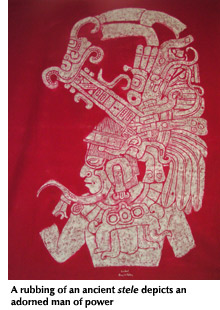| |
|||||
|
Traces of ancient Maya on exhibit | ||||
|
November 21, 2005 |
|||||
 Anthropology
Professor Gary Pahl's archaeological research in Honduras and Guatemala
about 30 years ago has spawned an SFSU exhibit, "Traces of the Ancient
Maya." Students in his Ancient Maya course designed the exhibit
while studying his research, which is based on more than 1,000 years
of Maya culture. Anthropology
Professor Gary Pahl's archaeological research in Honduras and Guatemala
about 30 years ago has spawned an SFSU exhibit, "Traces of the Ancient
Maya." Students in his Ancient Maya course designed the exhibit
while studying his research, which is based on more than 1,000 years
of Maya culture.
The exhibit, on display through Dec. 8 in the Hohenthal Gallery (Science and Engineering building, room 385) of the Treganza Anthropology Museum, consists of the archaeological methods Pahl used to study inscriptions on Maya artifacts that have been worn down and damaged over thousands of years. "Traces of the Ancient Maya" is on display from 2 to 5 p.m. Thursdays (excluding Thanksgiving), or by appointment. Admission is free. For details or to schedule an appointment to view the exhibit, call Sylvia Leng or Yoshiko Yamamoto at (415) 338-2046. The photographs on display used a raking light technique, in which the artifact is photographed under low light, using a spotlight to expose the faded inscriptions. Several large rubbings show the "stamp" of an original stone carving, made by placing a dampened and starched cloth over a relief and special ink to produce an image. Authentic Maya pottery and casts of stele -- large stone markers that depict important people -- are also on display. Pahl's upper-division class focuses on archaeological processes and the relationship between the Maya writing systems -- mainly hieroglyphics -- and culture. "Maya hieroglyphic writing was an elite enterprise, its topics the religious and political matters of greatest interest to the rulers and their families," reads a caption next to a rubbing of Maya text. The Maya developed the most complex system of writing known to ancient America, Pahl said. "[In their hieroglyphics] they used body features, jewelry, exaggerations and positioning as their way of expression," said Julia Carter, an anthropology major in Pahl's class. "They're supposed to be self-portraits, kind of how caricatures are done today." The exhibit spans from pre-classic to late classic Maya civilizations. "The late stuff is more realistic. The people kind of pop out at you," Pahl said. "The early stuff is more rococo, more detailed." --Student Writer Lisa Rau with Matt Itelson
|
|||||
 |
1600 Holloway Avenue, San Francisco, CA 94132 (415) 338-1111 |